|
Contact Info: MatchBook Products URL: www.matchbookdrive.com/ PalmInfoCenter.com Bottom Line: The Price:
The Cons:
PalmInfoCenter.com Ratings*:
*Maximum Rating is FIVE (5) InfoPalms |
MatchBook Drive CF Springboard Review (MD-001) for the Handspring Visor By Robert Zach 3/11/2001 If you follow the Handspring Visor scene then you just have to be aware of all the hub-bub lately over a CompactFlash Module for the Springboard Slot. The idea of limitless expansion on cheap CF cards has been the Holy Grail of the Visor world. And now it's here...
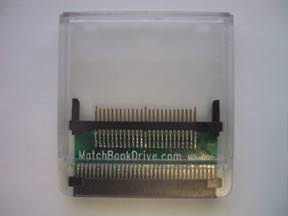 But, how about a quick history lesson first. Some time ago, the "community" learned that the Springboard port was pin equivalent to PCMCIA but not electrically equivalent. Then an enterprising soul in Japan posted some information on how to build your own CF adapter with a cheap PCMCIA to CF adapter and a few wiring and logic modifications. The only problem was software to drive the card wasn't ready. Then, along came Kopsis Engineering with their own do-it-yourself approach. Kopsis realized that by limiting the CF to memory only (no IO devices) the adapter was very simple to construct. Kopsis then set out to create the software. A lot of discussion and beta testing ensued in the eGroups.com FlashAdapter and MatchBookDrive forums. After quite a bit of development effort Kopsis Engineering Inc. had a commercially viable software solution. And, by this time MatchBook Products was poised to announce the first commercially available adapter. And that's where Palminfocenter.com steps in to bring you this review...... But wait! There's more to this saga! I have actually sat on this review for a few weeks because competition has stepped into the mix. What's that you say "competition". That's right, now there is a second commercially available CF Adapter from InnoPocket. I won't go into a comparison, my goal is to review the MatchBook drive here. If InnoPocket sends a CF Adapter we'll review it ;-) So why hold up the review then...well the announcement caused a whirlwind of activity around these little Handspring enhancers. They both use the same software, but the competition packaged it. Then, a "quality" war, the plastics were in question. And finally, of course, a price war. Well I think the dust has settled, and YOU the consumer have won the war with new packaging, software agreements, and lower prices!. This review will focus on reviewing the current MD-001 adapter (pictured) and what is coming from MatchBook Products. Here we go! Whew! The MD-001 is constructed from a Springboard slug made of clear plastic. It actually separates in two halves that snap together. Inside is the actual "adapter".
The other contributing factor to the failure is the very short guides for the CF card as seen below. These guides are standard fare for any CF accepting device; they're part of the connector. But, in this case they are so short that a few issues arise. The first problem is that there is not a smooth delivery of the CF card into the adapter. Secondly, the hole in the card appears to be cut out with a Dremel tool making for a loose fit. If the guides were longer, say all the way to the opening, and the opening was specifically molded, there would be a tighter fit, side supports to keep the opening from squashing, and a better (more solid/quality) feel for the product. 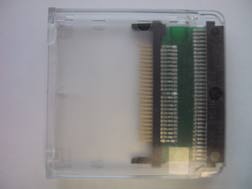
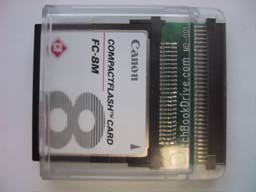
One other nitpick I have with the MD-001 is that the CF card does not sit flush in the adapter. Notice the second photo above and you'll see that the CF Card actually protrudes 1/8" from the adapter when fully seated. This doesn't effect operation but adds to the "home brew" feeling. So great, we have an adapter, but now we need software. Enter Kopsis Engineering. Once you spend the $30 on the adapter, you have to spend another $10 for the software from Kopsis. The biggest issue for some may now be the price, but this means that the MatchBook Drive is not a true SpringBoard module. It would be great is MatchBook could figure out how to write some sort of app that preps the CF Card with some sort of "loader" section that would automagically install/remove the software from the Visor upon insertion/removal if the adapter. The software itself is fairly straight forward. Kopsis provides the following files:
The software itself works great, but it too could use some freshening up. First of all, I'd like to see the format and card info applications condensed into the FA (FlashAdapter) File Mover software itself. Having them as separate apps just seems to clutter my Visor.
The one small "glitch" I found with the software installed and a CF card installed is in the Palm OS "info". As you can see here the "internal" memory pull-down (usually used for a Handspring FLASH SpringBoard) is now available. It would be nice if the driver software could somehow disable this when the card is plugged in, or better yet, make it actually report the space available on the CF Card. This may just become possible if the software gets ported to PalmOS 3.5.x and takes advantage of the VFS APIs provided by Palm. I imagine that since many Visors run OS 3.1, this was the least common denominator way to get the software out the door.
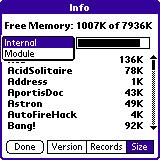
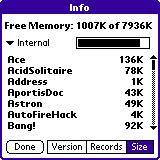
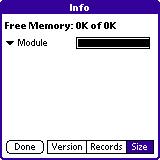
Speaking of VFS, that brings me to a wish list for this software. As a TRGpro user, I am accustomed to AutoCF. This TRG utility enables the user to install a CF card and have the applications installed on it be directly executable from CF. In function it works much like the Handspring Flash Springboard WITHOUT having to move the apps to RAM before executing. After all, what is the point of all this space if you can't use it to seamlessly expand internal RAM. Rumor has it Kopsis is looking into this, I'd love to know where they are! hint, hint ;) With all this said, my conclusion.....this is a great product and engineering marvel considering the all the technical hurdles that had to be jumped to make CF available on the Visor. As for the "whirlwind of activity" and my potentially disparaging remarks about the MD-001.... The MD-100 and MD-200 have been announced. See MatchBook Products website for details, but basically this is one hell of a Palm Community supporting company. They have answered all my concerns about the MD-001 with the MD-100. They have also done the following:
Hopefully MatchBook Products will replace my cracked MD-001 with a 100 or 200. Then I can provide a more detailed review of the updated products for you all. Update:
However, this was an endeavor that grew out of a hobby project, and frankly I did not conceive early on how big it would become, so I am thrilled with where we are currently. I will forward a sample of the MD-100 when it is available. The MD-200 has been delayed due to the need to raise additional capital for production. I look forward to receiving the MD-100 for review with the fixed plastics and the MD-100 taking care of the other nit picks in my review. This new version should make the MatchBookDrive a very nice, inexpensive solution to Handspring CF. |
Article Comments
(9 comments)
The following comments are owned by whoever posted them. PalmInfocenter is not responsible for them in any way.
Please Login or register here to add your comments.
![]() Comments Closed
Comments Closed
This article is no longer accepting new comments.
RE: Application running on CF Card
more than memory?
May be in next versions with detachable sleeve, they can create a sleeve for CF.
Visor modules are expensive and not-so-useful. I'll go for TRGPro.
Auto CF vs HS Flash SB
"As a TRGpro user, I am accustomed to AutoCF. This TRG utility enables the user to install a CF card and have the applications installed on it be directly executable from CF. In function it works much like the Handspring Flash Springboard WITHOUT having to move the apps to RAM before executing..."
There is a BIG difference between TRG's AutoCF and Flash Springboard. AutoCF merely copies an application from the CF card to the TRG Pro's RAM automatically for you and starts execution of the application. This means that you must have available free on-board memory to accomodate the application. So if you want to run a 2MB application, you better have 2 MB free on your TRG Pro (not the CF memory which is storage).
OTOH, the memory in the HS Flash is directly addressable by the CPU and is therefore true RAM. Applications truly run directly off the flash. You don't have to have free memory available on the Visor to run it. That's why Springboard is technologically superior to other expansion options which are ONLY storage options not memory expansion options. An analogy would be the difference between adding had-drives vs memory SIMM cards to your computer.
Most people miss this distinction because of the "point and click" ability of the AutoCF. I hope you were not making the same mistake.
Wk
RE: Auto CF vs HS Flash SB
"OTOH, the memory in the HS Flash is directly addressable by the CPU and is therefore true RAM. Applications truly run directly off the flash. You don't have to have free memory available on the Visor to run it. That's why Springboard is technologically superior to other expansion options which are ONLY storage options not memory expansion options. An analogy would be the difference between adding had-drives vs memory SIMM cards to your computer."
You are mistaken. The 8 MB Springboard Module is not "true RAM". If it were, then you would be able to modify databases directly on the CF. You can't, according to these two items from Handspring's 8MB Flash Module FAQ:
Q. Why can't I modify databases when they are located on the 8MB Flash Module?
A. Unfortunately, flash memory does not support writing small amounts of data in an elegant manner. As a result, modifications to database records are prohibited when the databases reside in flash storage such as the 8MB Flash Module. Copy your database back to handheld memory before you attempt to modify it.
Q. Why do some applications crash when run from the 8MB Flash Module?
A. The 8MB Flash Module does not support the creation or modification of databases in flash storage. It is likely that the application is attempting to either create or write to a database on the Flash Module and is not handling the resulting error gracefully. Check with your application software vendor to see if a newer version of the software is available. Handspring is working closely with software developers to ensure that popular Palm OS applications are compatible with the 8MB Flash Module.
So, these statements imply that programs do not run directly from Flash since in order to run it would have to write "small amounts of data" to the flash module. Instead, the apps write themselves to RAM to run. So, in that respect, the 8MB Springboard Module is just like AutoCF.
You can read "read-only" databases directly from the CF card, just like AutoCF can.
What makes the Springboard modules unique, and possibly superior, is that you can automatically launch apps when a Springboard module is connected.
RE: Auto CF vs HS Flash SB
You are correct when you point out that you cannot write to apps on the Springboard memory, which is Flash ROM. That's because to write to a database in Flash ROM you have to set the F-ROM in write-mode. This puts the whole F-ROM in write state and has dangerous repurcussions for other programs on the F-ROM. AFAIK, there is no way to write to only certain portions of Flash ROM that are relevant to the app writing to it.
OTOH, you can read apps directly from the Flash ROM. You see this in action in the Palm devices like the IIIxe, V, Vx etc that have F-ROM. The Springboard slot has the pins to directly address the Flash ROM in the memory module. So you see, there is no need to "copy" the app to the on-board RAM, as you suggest. That's why SB is TOTALLY different from the AutoCF wherein you have to copy the app.
Wk
RE: Auto CF vs HS Flash SB
RE: Auto CF vs HS Flash SB
And, TO THE ORIGINAL POSTER: The Springboard Flash obviously can't be treated like RAM by PalmOS because the DragonBall processor can only address 12MB of RAM (and PalmOS limits main memory to 8MB anyway).
Received my InnoPocket Friday
No problem putting card INTO the device, but big problems getting it back OUT! The CF card locks into the InnoPocket so tightly that it's very difficult to pull out. Twice I've torn off chunks of the CF card's plastic ridge using the ridge as something to grab onto to get a grip on the card to pull it out. And when I say get a grip, I don't mean with my hand -- gotta use something solid and pull like heck, which is what causes the plastic on the CF card to crack and break off.
That's my only complaint. Copies to/from the card are quite fast. I can load software onto the card from any of my computers (Mac or PC) via a CF reader, then copy the .PRC or .PDB files to the Visor, as an alternate method (vs. HotSync cradle) of installing stuff.
If in the future, Palm OS 4 or other software permits the CF card to be used more like a hard disk (i.e., stuff on the card gets copied into memory as needed, transparently), that would be a great bonus.
I ordered the InnoPocket the same day that the MatchBook Drive dropped in price to $25 with free shipping. Had I known they were doing that, I may well have gone with the MatchBook Drive.
Latest Comments
- I got one -Tuckermaclain
- RE: Don't we have this already? -Tuckermaclain
- RE: Palm brand will return in 2018, with devices built by TCL -richf
- RE: Palm brand will return in 2018, with devices built by TCL -dmitrygr
- Palm phone on HDblog -palmato
- Palm PVG100 -hgoldner
- RE: Like Deja Vu -PacManFoo
- Like Deja Vu -T_W

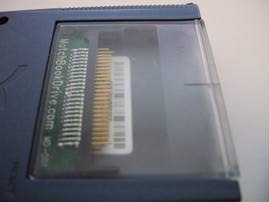 I found that the plastic was rather fragile, even though it is claimed to be virtually indestructible. As you can see in this picture, mine actually cracked. This happened because there was no CF card in the slot to provide rigidity, leaving an open hole on the back of my Visor that can easily be squashed.
I found that the plastic was rather fragile, even though it is claimed to be virtually indestructible. As you can see in this picture, mine actually cracked. This happened because there was no CF card in the slot to provide rigidity, leaving an open hole on the back of my Visor that can easily be squashed.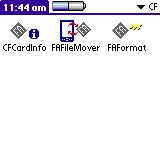
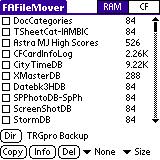


Application running on CF Card